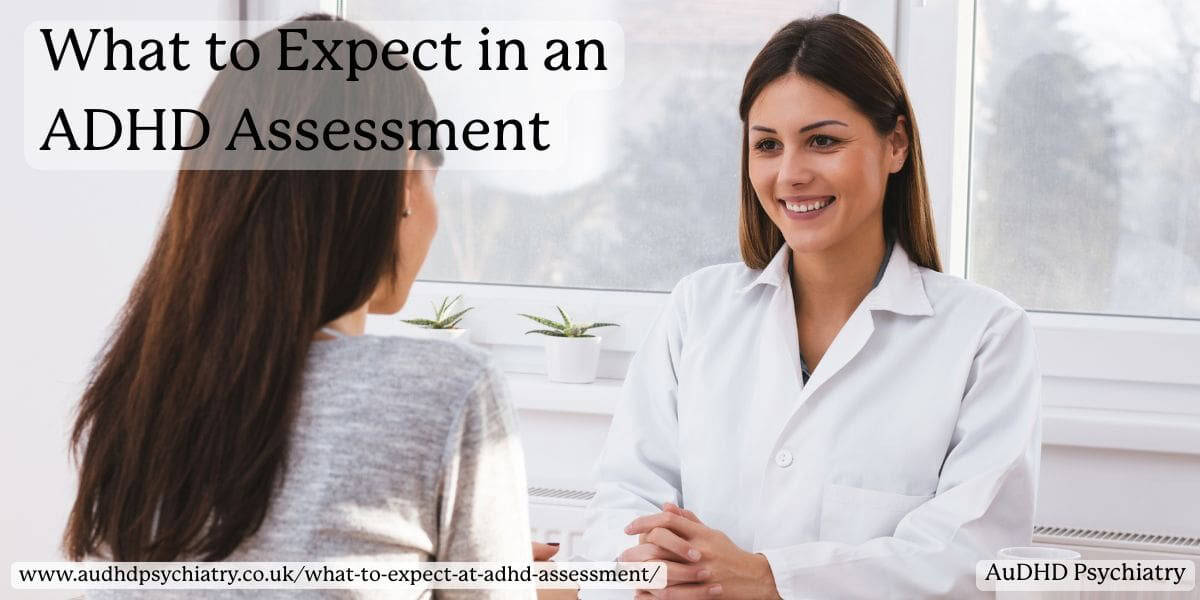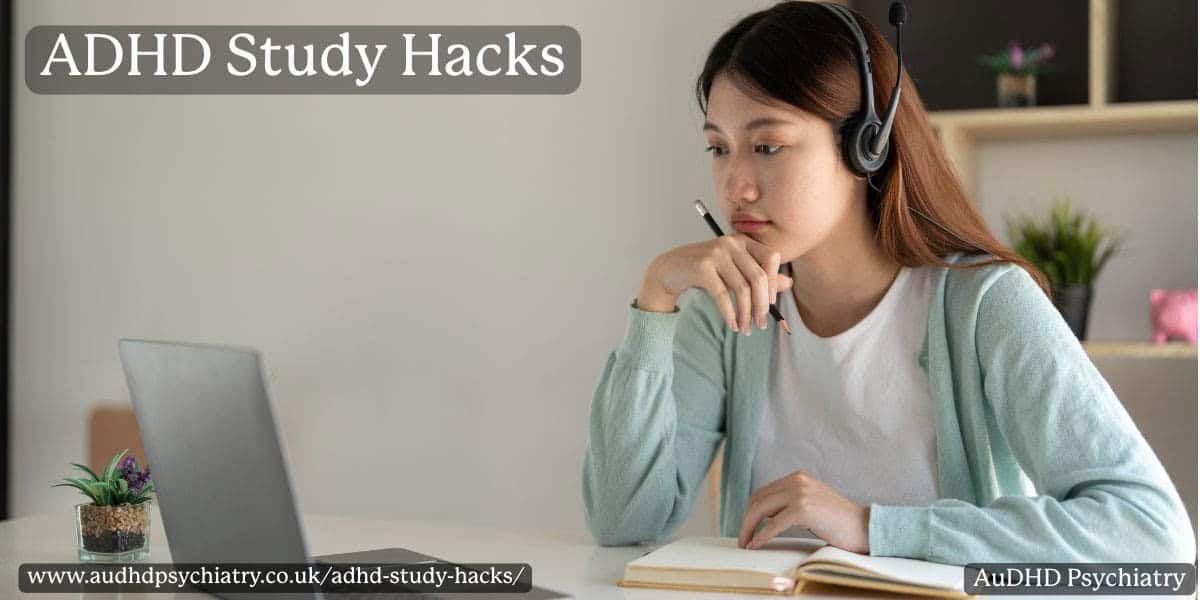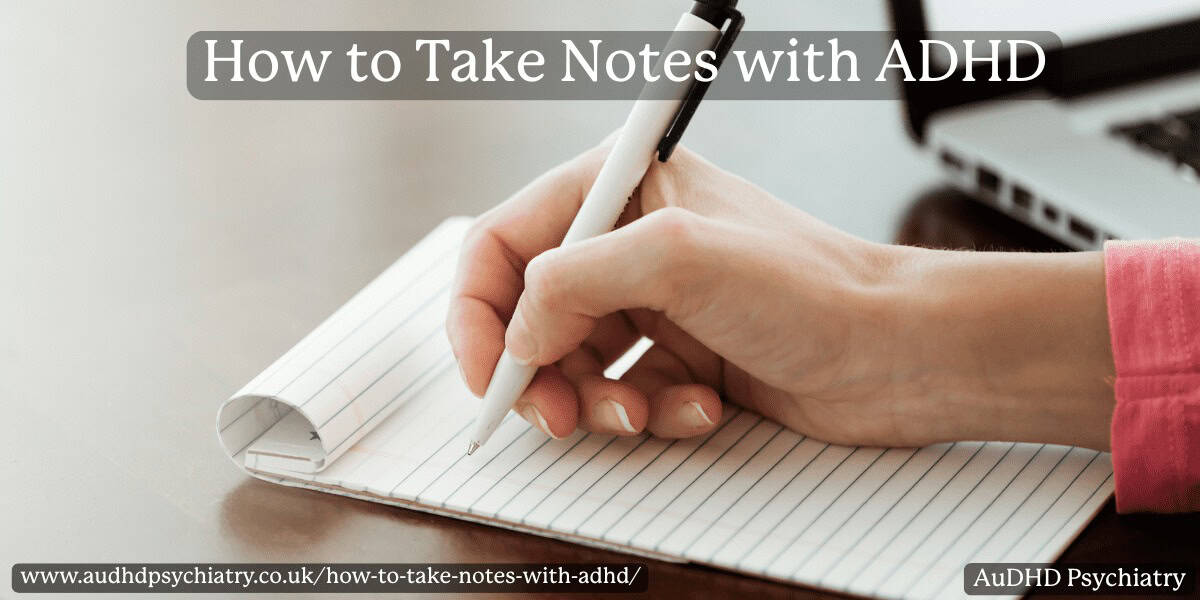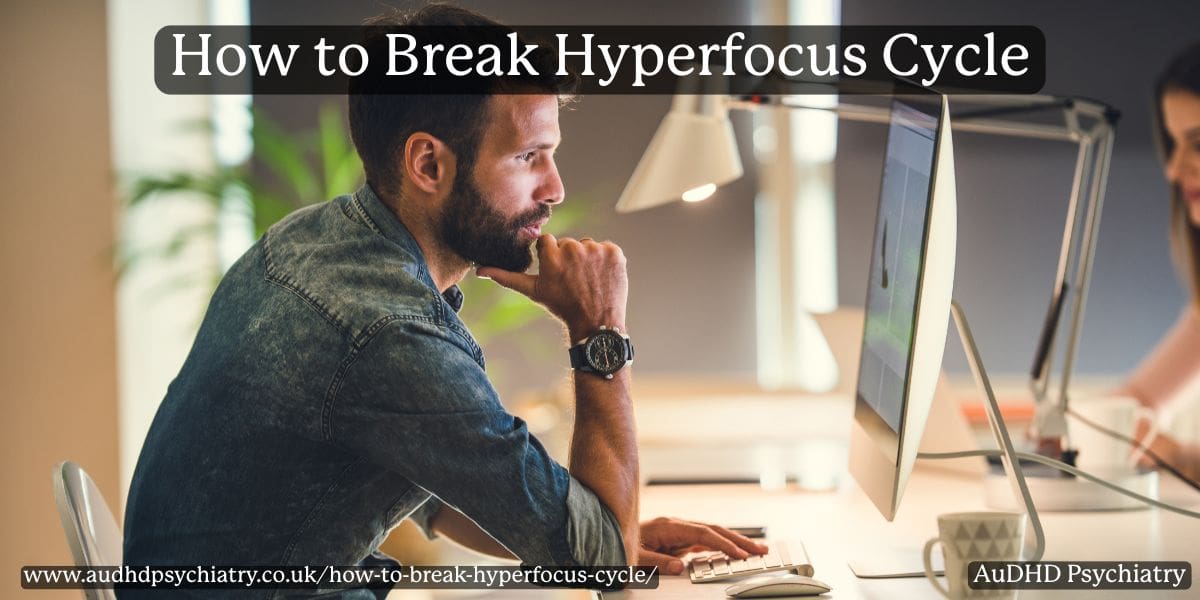
Hyperfocus can feel productive, until it isn’t. For individuals with ADHD, the ability to concentrate intensely on a task can lead to valuable progress. But when that focus becomes difficult to shift or disconnect from, it can interfere with basic needs, daily responsibilities, and emotional well-being.
The hyperfocus cycle refers to this pattern: entering a deep state of concentration, losing track of time or surroundings, and struggling to stop. While often misunderstood as a strength, unmanaged hyperfocus can have unintended consequences.
This guide explains what hyperfocus is, why it happens in ADHD, and how to interrupt the cycle using practical, evidence-informed strategies. From early warning signs to tools like the Pomodoro Technique, we outline clear steps to help regain control, restore balance, and reduce burnout risk.
If you’re finding it hard to switch off, this article offers strategies to help you step out of hyperfocus and reset.
What Is Hyperfocus and Why Does It Happen?
Hyperfocus is a state of intense mental concentration that can cause someone to become deeply absorbed in a single task or interest. For individuals with ADHD, hyperfocus is a well-documented phenomenon, though it’s not formally listed in the Diagnostic and Statistical Manual of Mental Disorders (DSM-5), many clinicians and ADHD specialists acknowledge it as a common experience.
Unlike typical distraction, hyperfocus involves laser-like attention on something stimulating, often a creative project, special interest, or even a video game, to the exclusion of basic needs or external cues. While this may sound like a useful coping mechanism, it can also make transitioning between tasks extremely difficult.
The Role of the ADHD Brain
Hyperfocus is believed to result from differences in the brain’s reward systems. Individuals who have ADHD often have lower levels of dopamine, which affects motivation, executive functions, and attention regulation. When a task feels especially engaging, the ADHD brain can become “locked in”, not out of conscious choice, but because it finally finds something rewarding enough to sustain focus.
Hyperfocus vs Flow State
Though it may resemble the “flow state” described in psychological research, hyperfocus is less deliberate and harder to exit. Flow usually occurs with effortful skill-building and awareness of time and goals. In contrast, hyperfocus often comes with time blindness, an inability to sense how long you’ve been absorbed or when to stop.
Understanding these neurological and behavioural patterns helps frame hyperfocus not as a flaw, but as part of the unique way ADHD brains engage with the world. For more on how ADHD impacts executive functioning, you may find our article on how ADHD affects the brain helpful.
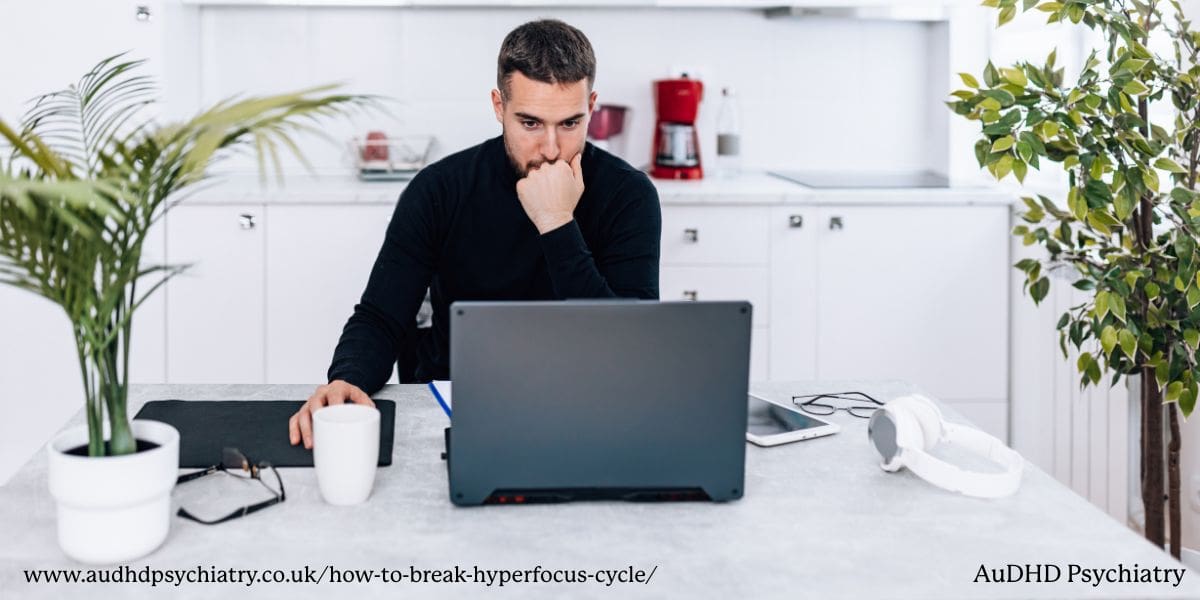
What Is the Hyperfocus Cycle?
The hyperfocus cycle refers to the repeated pattern of becoming fully absorbed in a task, remaining in that state for an extended period of time, and struggling to disengage. While some people describe this cycle as a “superpower,” its effects on daily life, including disrupted routines, sleep loss, and emotional exhaustion, often suggest otherwise.
The cycle typically begins with high interest or urgency. A task, whether it’s responding to emails, building a project, or scrolling through social media, grabs your full attention. From there, time begins to slip. You may ignore hunger, overlook messages, or feel disconnected from your surroundings. The external world becomes less relevant.
Why ADHD Brains Stay Stuck
This intense absorption is fuelled by the ADHD brain’s heightened sensitivity to novelty and reward. Once locked in, it becomes difficult to transition, even when you’re aware that time is passing. Executive functions that help shift attention are often compromised in ADHD, making it harder to pause or reassess.
The Consequences of Staying Too Long
Remaining in a hyperfocused state for too long can contribute to the ADHD burnout cycle, a pattern of extreme effort followed by mental crash. Many describe feeling “wired but tired” or unable to stop, even though their energy levels are fading.
Common consequences of prolonged hyperfocus:
- Skipped meals or neglected hydration
- Reduced sleep or disrupted sleep patterns
- Emotional crash or irritability
- Difficulty switching tasks
- Increased guilt or self-blame
- Overlooked social and professional responsibilities
Breaking this pattern means learning to recognise early signs, set time limits, and build routines that allow for regular breaks. Without this awareness, the cycle is likely to repeat, reinforcing guilt, stress, and difficulty managing other important tasks.
ADHD and Hyperfocus: It’s Not a Lack of Attention
One of the most common misconceptions about ADHD is that it reflects a lack of attention. In reality, ADHD is a disorder of attention regulation, not a short attention span. People with ADHD often swing between distraction and intense focus, making it hard to find a balance between daily responsibilities and special interests.
Hyperfocus is often misunderstood because it contradicts the stereotypical view of ADHD. If someone can focus for hours on a creative project or specific task, how can they possibly have ADHD? This false assumption overlooks how context, environment, and emotional engagement influence attention in neurodivergent people.

Attention Fluctuates; It Doesn’t Disappear
People with ADHD may struggle to concentrate on mundane or low-stimulation activities, such as household chores, reading long documents, or completing forms. Yet when the brain is activated by interest or urgency, it may enter a hyper focused mode that makes everything else fade away. This can happen with video games, work assignments, or even scrolling endlessly through a single topic online.
The Role of Executive Functions
Executive functions like shifting attention, prioritising tasks, and resisting distractions are often impaired in ADHD. Hyperfocus bypasses these systems by locking into one single task, which feels easier than switching between competing demands.
Understanding this pattern is key to reducing shame or self-blame. Hyperfocus isn’t about being lazy or undisciplined. It’s how the ADHD brain responds to stimuli. With tools like self-awareness, time management techniques, and environmental adjustments, it is possible to support healthier focus patterns.
Hyperfocus vs Hyperfixation: What’s the Difference?
For many individuals with ADHD or those on the autism spectrum, it can be hard to tell the difference between hyperfocus and hyperfixation. While both involve intense mental absorption, they emerge from different emotional and neurological triggers, and each affects daily life in distinct ways.
Understanding the Meaning Behind Each Term
Hyperfocus is most commonly seen in ADHD, where the brain’s reward system responds to a specific task by tuning out the external world. People may lose track of time or forget basic needs while focusing on a creative project, a game, or a work assignment. The behaviour isn’t always deliberate. It can feel like being pulled into something without realising it.
In contrast, hyperfixation is usually more emotional in nature. It involves an extended and sometimes obsessive focus on a particular topic, person, or activity. This is more commonly associated with autism spectrum disorder, but it can also affect neurodivergent people with ADHD. A person may repeatedly think about or return to the same subject for comfort, familiarity, or emotional regulation. For instance, someone with ADHD hyperfocus on a person might find it difficult to stop thinking about a specific individual, especially if that connection feels deeply stimulating or unresolved.
Why It Matters
Although both can disrupt routine, hyperfixation often involves emotional attachment or repetition, while hyperfocus centres around high performance or single-task immersion. Understanding the distinction can help you manage hyperfocus more effectively by recognising the source of your attention. Is it a temporary burst of concentration on a task? Or is it a longer-lasting fixation tied to emotional needs?
This difference is crucial when exploring ADHD how to focus strategies. Many people confuse the two and feel frustrated when traditional advice doesn’t work. By naming the pattern accurately, you gain insight into what type of support or intervention might help.
Knowing your attention style can improve your ADHD attention span and help prevent burnout by creating boundaries before a harmless interest turns into an unhealthy obsession. If you’re unsure which applies to you, tracking your focus patterns in a journal or talking with an ADHD specialist can offer helpful clarity.
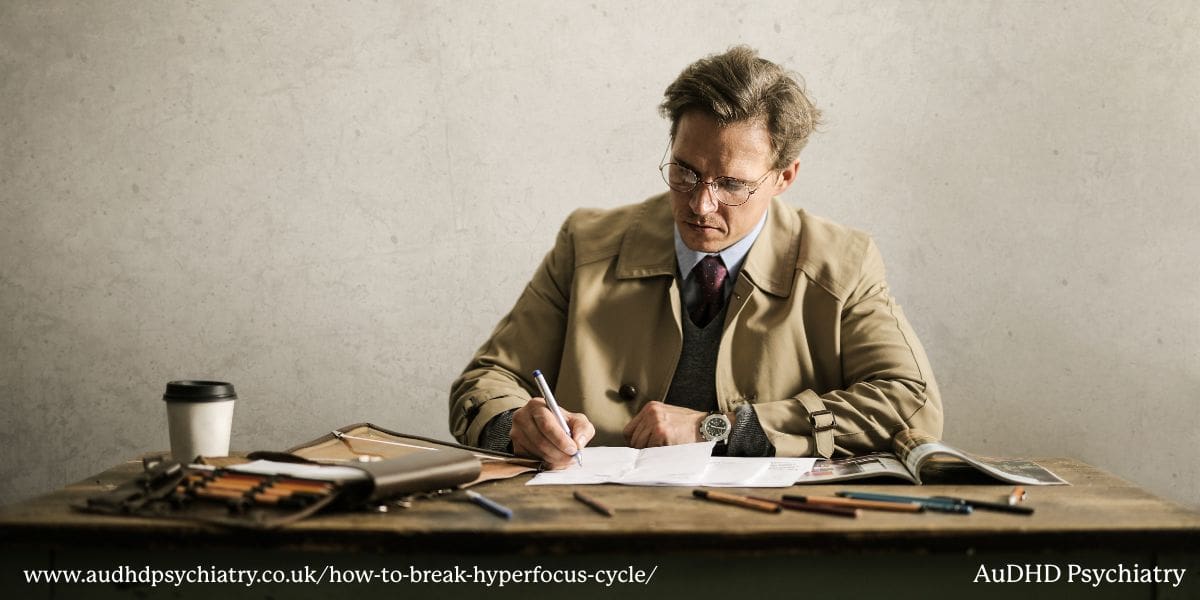
The Dual Nature of Hyperfocus: Superpower or Struggle?
Hyperfocus is often described as a double-edged sword. On one side, it can unlock deep creativity and productivity. On the other hand, it can lead to burnout, sleep disruption, and neglected responsibilities. Understanding this contrast is key to managing hyperfocus intentionally.
When Hyperfocus Feels Like a Gift
In some cases, it allows individuals with ADHD to excel at a specific task. It’s a state of intense concentration where everything else fades. Writers, designers, and coders, for example, often describe this hyperfocused state as one where they produce their best work. When channelled correctly, this kind of focus can lead to high performance and fulfilment.
In fact, some neurodivergent people create intentional “hyperfocus windows” using techniques like time-blocking or the Pomodoro Technique. This allows them to complete important tasks while still making time for breaks and recovery.
When Focus Becomes a Problem
Unfortunately, the flip side of hyperfocus is rarely discussed. Spending time in a hyper-focused state for an extended period can disrupt daily life. Meals are skipped, important things go ignored, and household chores pile up. Many people report feelings of emotional exhaustion after hyperfocusing, even if the task itself was enjoyable.
The problem isn’t the hyperfocus itself, but rather the lack of a transition out. Because attention regulation is affected in ADHD, it becomes hard to set boundaries or re-enter the external world. When that happens repeatedly, it can contribute to the ADHD burnout cycle.
By learning to recognise when hyperfocus is helping versus when it’s harming, individuals can begin to reclaim some control. Balancing work-life demands, setting time limits, and building recovery time into the day are all ways to enjoy the benefits of hyperfocus, without getting stuck in it.
How to Break the Hyperfocus Cycle: 8 Practical Strategies
Breaking the hyperfocus cycle isn’t about removing deep concentration entirely. It’s about learning how to step out of it before it becomes harmful. For people with ADHD, this often requires external cues, self-awareness, and structured coping mechanisms to overcome the pull of hyperfocused attention. Below are eight practical strategies to help regain control, manage time, and support cognitive function.
1. Acknowledge When You’re Stuck
The first step is recognising that you’re in a hyperfocus state. This awareness can be difficult, especially if you’re deeply immersed in a personal interest or creative project. Look for signs such as skipping meals, ignoring messages, or losing track of time. Hyperfocus symptoms often mimic flow but come with less conscious control. The moment you notice these signs, pause and check in with yourself.
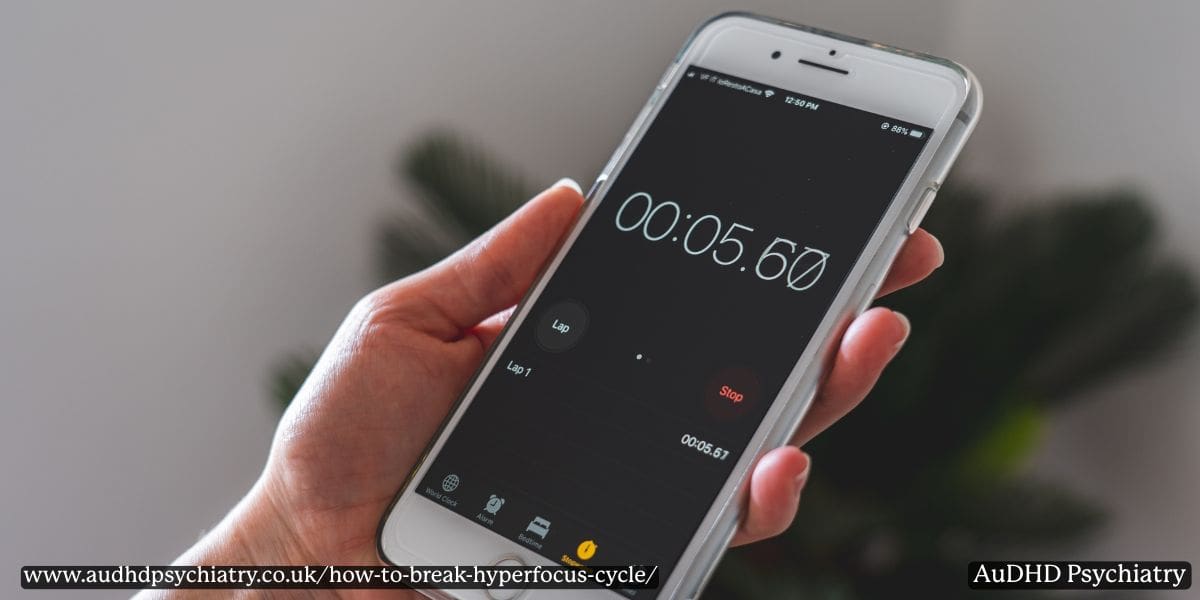
2. Use External Cues and Timers
Time blindness is a common ADHD symptom that makes it hard to notice how long you’ve been focused. Timers or apps such as Forest can help by creating visual and auditory reminders. The Pomodoro Technique involves focusing on a task for 25 minutes, followed by a short 5-minute pause to reset your attention. It is a powerful tool for maintaining productivity without falling into hyperfocus.
Set timers not just for work but also for breaks, meals, and screen time to maintain a healthy rhythm. Find more tips on managing ADHD in the workplace in this article.
3. Reconnect With Time and Your Future Self
When you’re stuck in hyperfocus, it’s easy to forget about the long-term consequences of ignoring important things. Visualisation techniques can help. Try asking: What will my future self need in an hour? Will I be hungry, behind on tasks, or emotionally drained? Practising this mental shift supports better executive function and can gently disrupt the hyperfocus cycle.
4. Set Clear Boundaries Around Tasks
Boundaries reduce the chance of hyperfocus taking over. Limit how long you spend on single tasks, especially those that trigger hyperfocusing, such as social media or gaming. Use a structured schedule to segment your day, and physically separate work zones from rest zones where possible. ADHD brains often need visible cues, so keep sticky notes or checklists nearby to help you move between tasks.
5. Lean on Support Systems
Accountability can be a game changer. Whether it’s a co-working session, a friend texting reminders, or a body double setup, social interaction helps break hyperfocus isolation. For neurodivergent people, structured support groups can also reinforce positive routines and offer perspective when your own self-awareness slips.
6. Try “Pause and Plan” or Reset Breaks
Mid-task resets are useful for regaining cognitive control. Stand up, stretch, or step away for a short break. A two-minute pause can refresh your attention span and help you return with a clearer sense of purpose. These breaks also give you space to reflect: Is this task still a priority? Should I switch focus?
7. Use Transition Activities to Shift Gears
Moving out of a hyperfocused state is easier with a transition task. Choose something low-effort but active, such as washing dishes, walking the dog, or watering plants. These activities act as a bridge between the hyperfocused state and your next responsibility. They also help restore energy levels and ground your attention in the physical world.
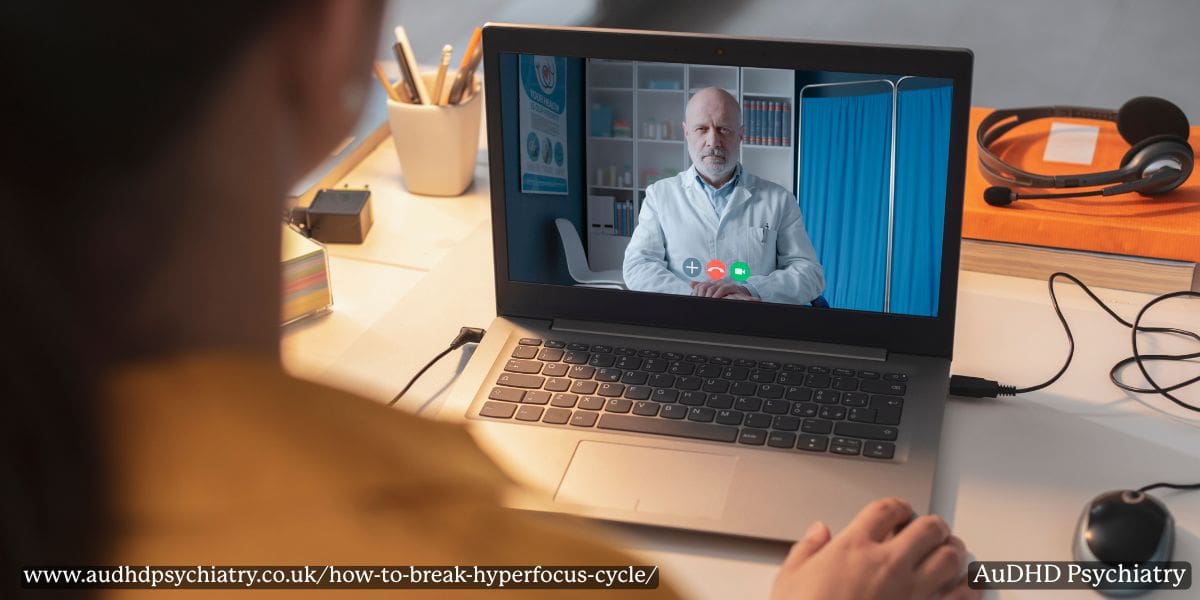
8. Seek Professional Help When Needed
If hyperfocus is interfering with your work, relationships, or even your well-being, it may be time to seek professional help. ADHD specialists, therapists, or an ADHD coach can offer individualised strategies that support your specific challenges. Tools like cognitive behavioural therapy (CBT) or adjustments to ADHD medication may also help regulate attention and manage the intensity of hyperfocus.
Breaking hyperfocus takes practice, but with consistent strategies and external support, it becomes easier to regain balance and reduce the long-term impact of unmanaged focus.
What to Do After Breaking Out of Hyperfocus
Recovering from a hyperfocused state is just as important as breaking it. The brain and body often need time to transition back into balance, especially after an intense period of concentration. Without this recovery phase, you may find it difficult to regain momentum for the rest of your day or risk entering the ADHD burnout cycle.
Reconnect With Basic Needs First
Once you’ve broken free, check in with your physical needs. Rehydrate, eat a nourishing snack or meal, and do a few stretches. These simple actions help restore energy, improve focus, and send the brain signals that the task is done. Movement can also stimulate dopamine production, which is often depleted after prolonged focus.
Reflect on What Was Achieved
Rather than jumping straight into another task, pause to reflect on what you completed. This creates a sense of accomplishment that reinforces positive productivity habits. It’s especially helpful for those with ADHD who may struggle to recognise progress unless it’s consciously acknowledged.
Reintegrate Into the Day’s Broader Plan
After a period of hyperfocus, it’s easy to lose sight of your original schedule. Reviewing your to-do list, checking your planner, or resetting your timer can help re-centre your attention. If your original plan now feels overwhelming, try using prioritisation tools like the Eisenhower Matrix to decide what still needs doing and what can wait.
Getting back into routine gradually supports executive function and reduces stress.
For a quick reference, here are things to try after a hyperfocus session:
- Drink water and have a light snack or meal
- Do 2–5 minutes of light stretching or movement
- Reflect on what you accomplished; write it down if that’s helpful
- Check your planner or task list to reset priorities
- Choose a low-effort task to ease back into your routine
Benefits of Tapping Into Hyperfocus
When used wisely, hyperfocus can enhance productivity, creativity, and personal fulfilment. Many individuals with ADHD find that their best work happens when they’re immersed in something they genuinely enjoy or feel passionate about.

Deep Work and Enhanced Creativity
Hyperfocus allows for deep work: the kind of uninterrupted, high-quality concentration that results in meaningful output. Whether it’s writing, designing, coding, or solving problems, being able to concentrate for hours is an asset in both professional and creative fields.
Higher Task Satisfaction
The sense of achievement after completing a hyperfocused task is often intense. For individuals with ADHD who struggle with motivation and follow-through, finishing a task in this state can be deeply validating. This sense of progress also supports better emotional well-being.
Boosting Self-Esteem and Purpose
When hyperfocus is channelled constructively, it can boost self-confidence and reinforce a sense of purpose. It may even help reduce negative self-talk, which is common in ADHD. Regular success experiences can act as a buffer against internalised criticism and self-doubt.
The trick is learning to set up supportive conditions so that hyperfocus becomes an ally. Using ADHD tools like visual reminders, time limits, and dopamine-friendly routines can help you tap into this strength without risking emotional fatigue or imbalance.
Hyperfocus and Emotional Support: When to Step In
While hyperfocus is often a personal experience, it doesn’t occur in isolation. Friends, family, or teachers may observe when someone with ADHD is “lost” in a task and unsure of how or when to intervene. Emotional support holds a critical role in helping someone return to balance.
Recognise the Signs
If a loved one is skipping meals, ignoring conversations, or appearing emotionally distant while fixated on one task, they may be in a hyperfocus state. Rather than calling it out directly, start with a gentle prompt like, “Hey, have you eaten today?” This approach respects their autonomy while offering a helpful nudge.
Support, Don’t Shame
Avoid framing their hyperfocus as a flaw. Comments like “You’re obsessed” or “You never listen” can lead to shame, which only increases withdrawal. Use non-judgmental language and offer alternatives, such as suggesting a break or offering to help transition them out of the task.
Build a Supportive Environment
Whether you’re a parent, partner, or colleague, helping someone create ADHD-friendly habits is often more effective than direct confrontation. This might include setting shared reminders, co-working sessions, or regular check-ins. Encouraging them to explore ADHD coping mechanisms, such as coaching or therapy, can also be transformative.
Healthy relationships require understanding and flexibility, especially when supporting someone with ADHD. With the right tools and approach, emotional support can help break the hyperfocus cycle without disrupting trust or autonomy.
Finding Balance Beyond Hyperfocus
Hyperfocus isn’t inherently good or bad. It’s how the ADHD brain engages deeply with what feels meaningful. But when it interferes with basic needs, routines, or relationships, it becomes essential to step back and reassess. Recognising when you’re stuck, using external cues like timers, and building structured transitions can help you break the cycle before burnout sets in.
Learning to work with hyperfocus, not against it, opens the door to healthier productivity. Whether it’s using intentional focus windows or planning post-focus recovery, small changes can lead to more sustainable routines. And if hyperfocus is affecting your well-being, you don’t have to figure it out alone.
We offer personalised ADHD assessments and treatment plans designed to support how your brain works best. Book a call today and take the next step toward better balance, focus, and well-being.
You Might Also Like

